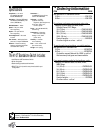
Technically Speaking
C
ompared with traditional
routers and bridges, Ethernet
switches offer distinct
advantages in performance, ease
of use, and cost.
In particular, an Intel
®
Express
410 Standalone Switch can help
alleviate bottlenecks in your
client/server environment. A
workgroup-based switch such
as the Express 410 takes a logical
approach to easing congestion:
It boosts performance on a
portion of the network and divides
the local network so fewer users
occupy a segment.
The switch also provides each
high-performance device (such a
server or a switch uplink) with its
own dedicated segment, one that
can run at the same speed as the
other switched ports or at higher
speeds.
To further ease the flow of
traffic, the Express 410T employs
flow control, which temporarily
suspends a transfer of data from a
sending workstation until its
destination port is ready to receive
it. Flow control applied during
Ethernet traffic bursts—when
switch buffer memory is full—
helps prevent information from
being dropped and, in turn, saves
you from costly delays.
Many conventional bridges,
routers, and switches rely on
large, expensive buffers to hold
packets that can’t be transmitted.
However, if the destination
segment becomes overloaded,
incoming data can overrun the
buffer, forcing the device to drop
excess packets. And, although the
sending nodes’ NIC software
detects dropped packets, the
solution typically involves a very
inefficient time-out mechanism.
Flow control goes to the
source—before the segment is
flooded. When a port’s internal
buffers near capacity, flow control
enables the switch to transmit a
mock collision (also known as a
jam pattern) back to the source
node. The sending node sees the
interruption as a collision and
backs off. When the switch has
emptied its internal buffers, it
directs the sender’s NIC to
retransmit the packet from its
hardware buffers.
You can enable and disable
flow control for each port on the
Express 410T. By default, flow
control is enabled. The method of
flow control depends on whether
the ports are set to full or half
duplex. For instance, if the port is
operating at full duplex, the switch
sends out an 802.3x PAUSE frame,
instead of a collision, to delay
traffic.
And, as a store-and-forward
switch, the 410T stores the
incoming frame in an internal
buffer and delays transmission
until the switch successfully
completes packet error-checking.
10
Workgroup Application:
Older 10-Mbps Hub or Switch
Connected to Port 1 Using
Straight-Through Cable
File Server Connected Using
Straight-Through Cable
100-Mbps Clients
10-Mbps Clients
10-Mbps Connections
100-Mbps Connections
Shared Printer
Stack of Express 330T Stackable Hubs (EE330TX16)
Connected to the Switch Using Crossover Cable
Intel Express 410T
Standalone Switch, 16-Port
(ES410T16)
The Express 410T can serve as the backbone for a small network. Its MDI/MDI-X button allows the
switch to connect to other switches and hubs using straight-through cables (instead of crossover cables).
All ports on the switch are MDI-X, and the button is used to toggle Port 1 to MDI.





